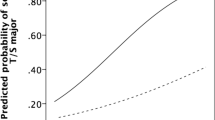Conclusion
Considering the technology gender gap that exists today, there can be no doubt that our current educational system is not engaging female students in technology or awakening them to possibilities of the technology industry as a career. Females are not afraid of computers or lack the ability to master computer skills, but they find the computer environment objectionable (http : / / www.aauw.org/2000/ techsavvybd.html). Several factors within the educational system heighten these objections and impede female progression through technology classes. It is these factors that our educational system must address.
Single-sex computer classes offer female students the educational advantages of learning in a comfortable, non-threatening classroom environment where they are encouraged to enthusiastically participate in classroom discussions and activities (Kumagi, 1995). In these classes, curriculum may be adjusted to reflect the need females to see computers as productivity tools (Caplice, 1994). As a result of positive experiences gained while attending single-sex computer classes, females are more likely to pursue higher level computer classes.
Although it is possible to argue that single-sex computer classes do not mirror the real world females must contend with once outside the classroom, they are, however, effective interim interventions to enable females to lessen the current technology gap (Kumagi, 1995).
Similar content being viewed by others
References
Brown, E, & Russo, C. (1999, January ). Single-sex schools, the law, and school reform. Education &Urban Society, 31(2), 154–158.
Burgess, A. (1990). Co-education: the disadvantages for schoolgirls.Gender & Education, 2(1), 91–95.
Camp, T. (2001). Women in computer sciences: Reversing the trend.Syllabus, 15(1), 24–26.
Caplice, K. (1994). The case for public single-sex education. HarvardJournal of Law & Public Policy, 18(1), 227–291.
Francis, L, Kat, Y., & Yaacov, L. (1996, July). The Gender Stereotyping of Computer Use Among Female Undergraduate Students in Israel and the Relationship with Computer Related Attitudes,Journal of Educational Media, 22(2), 79–86.
Gillihrand, E., Robinson, R., Brawn, R., & Osborn, A. (1999). Girls’ participation in physics in single sex classes in mixed schools in relation to confidence and achievement. InternationalJournal of Science Education, 21 (4), 349–362.
Haag, P. (2000). K-12 single-sex education: what does research say? (ED444758). : (ERIC Document Reproduction Service No. ED444758)
Hanor, J. (1998). Concepts and strategies learned from girls’ interactions with computers. Theoryinto Practice, 37(1), 64–71.
Harker, R. (2000, June). Achievement, gender and the single-sex/coed debate.British Journal of Sociology of Education, 21(2), 203–218.
Houtx, L., &. Gupta, U. (2001). Nebraska high school students’ computer skills and attitudes.Journal of Research on Computing in Education, 33(3), 316–327.
Jackson, C., & Smith, I. (2000, December). Poles apart.? an exploration ot single-sex and mixed-sex educational environments m australia and england.Educational Studies, 26(4), 409–422.
Kay, R. (1992) Understanding gender differences in computer attitudes, aptitude, and use: an invitation to build theory,Journal of Research on Computing in Education, 25(2), 159–172.
Kumagi, J. (1995, November). Do single -sex classes help girls succeed in physics’.Physics Today, 48(11), 72–74.’
Lee, V., & Lockheed, M. (1990). The effects ot single-sex schooling on achievement and attitudes in nigeria. (SE552026). (ERIC Document Reproduction Service No. EJ476667)
Mallam, W. (1993). Impact of schooltype and sex of the teacher on female students’ attitudes toward mathematics in Nigerian secondary schools (SE552026). Nigeria: (ERIC Document Reproduction Service No. EJ476667)
Marsh, H.W. & Rowe, K.J. (1996). The effects of single-sex and mixedsex mathematics classes within a coeducational school: a reanalysis and comment.Australian journal of education, 40 147–162.
McEwen, A., & Knipe, D. (1997, Nov). The impact of single-sex and coeducational schooling on participation and achievement in science: a 10-year perspective.Research in Science & Technological Education, 97(15), 223–233.
O’Reilly, E., & Mottet, L. (2001). Single-sex education. GeorgetownJournal of Gender & the Law, 2(2), 467–476.
Reisman, D. (1993, March/April). Quixotic ideas tor educational reform.Society, 30(3), 17–24.
Sacks, C., & Bellisimo, Y. (19931994). Attitudes toward computers and computer use: the issue of gender.journal of Research on Computing in Education, 26(2), 256–269.
Silverman, S., & Pritchard, A. (1996). Building their future: girls and technology education in Connecticut.journal of Technology Education, 7(2), 41–53.
Stepulevage, L. (2001). Gender/Technology Relations: complicating the gender binary.Gender and Education, 13(3), 325–338.
Streitmatter, J. (1998, November). Single-sex classes: female physics students state their case.School Science & Mathematics, 98(7), 369–375.
The American Association ot University Women. (1992). How schools shortchange girls Executive Summary (1992).
The American Association ot University Women. (2000). Tech-Savvy: Educating girls in the new computer age. Retrieved April 2, 2002 fromhttp : // www. aauw.org/2000/ techsavvy.html
The Fate of a Single Sex Classroom is..., (1996). Retrieved April 2, 2002, fromhttp://www.aclu.org/news/ w070496c.html
Warrington, M., & Younger, M. (2001). Single-sex classes and equal opportunities for girls and boys: perspectives through time from a mixed comprehensive school in England.Oxford Review of Education, 27(3), 339–356.
Young, B. (2000). Gender Differences in Student Attitudes Toward Computers.Journal of Research on Computing in Education, 33(2), 204–216.
Rights and permissions
About this article
Cite this article
Swain, S.L., Harvey, D.M. Single-sex computer classes: An effective alternative. TECHTRENDS TECH TRENDS 46, 17–20 (2002). https://doi.org/10.1007/BF02824155
Published:
Issue Date:
DOI: https://doi.org/10.1007/BF02824155




